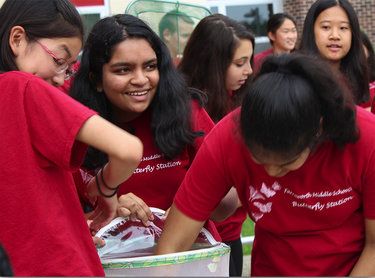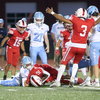GCSD board aims for social justice, plans to set up coalition
Enterprise — Michael Koff
Guilderland students — shown here in an earlier year at the Farnsworth Middle School butterfly station — are diverse. According to the superintendent, 26 percent of Guilderland students are non-white while just 1 percent of Guilderland faculty and staff are non-white. The school board wants to increase workforce diversity.
GUILDERLAND — “Together we will create brave space/ Because there is no such thing as a ‘safe space,’” said Seema Rivera to the other eight Guilderland School Board members on a two-hour video conference to set goals.
Rivera, the board’s president, went on, “We exist in the real world/We all carry scars and we have all caused wounds.”
Rivera was reading a poem by Micky ScottBey Jones. A justice practitioner at the Faith Matters Network, Jones, a Black woman, has said, “It’s not so much about establishing some perfect world, but about creating it by working on it together — personal and social transformation at the same time. And all of that is not safe.”
“Goal-setting can be messy,” said Rivera after she read the poem. She told her colleagues, “Nothing is set in stone as we talk.”
The Guilderland School Board plans to formalize its goals at its Aug. 11 meeting.
“The part I’m very excited about is putting together a group appointed by the board to look at the aspects of social justice …,” said Superintendent Marie Wiles this week. “There’s a lot that can be done,” said Wiles, naming curriculum, hiring, discipline, and policy.
At the board’s goal-setting session on July 21, board member Rebecca Butterfield had suggested creating a standing board committee to handle social-justice issues.
“The more you involve people, the better the results will be,” said board member Barbara Fraterrigo. She recommended a large task force like the one, broken into different committees, that came up with plans on how to use empty classrooms rather than close a neighborhood elementary school.
Board member Luciano Alonzi suggested creating a student organization to also address social justice. “They could educate other students,” he said.
“I think we need student voices in this,” agreed Wiles.
Board member Ben Goes said equity would benefit all students. He cited the “no hat” policy at the middle school, which doesn’t consider other cultures. He recommended introducing more restorative justice — “not just Black students but all people of color from all traditions who should be accommodated in our school system.”
Gloria Towle-Hilt, the board’s vice president, agreed that student voices were essential and said the board could make assumptions that aren’t true. She urged, “Find the people that will challenge what we’re doing.”
Wiles told The Enterprise this week she liked the idea of a “Social-Justice Coalition.” She said, “A task force goes away when the task is completed.” She envisions asking people at the school and in the community at large who are interested in serving as part of the coalition to write a letter of interest, saying what they’d bring to the coalition and that they’d have time for the commitment.
Asked about the timing of massive social change in the midst of a pandemic and economic uncertainty, Wiles told The Enterprise, “When you take away the structure, it lays bare the haves and the have-nots.”
As schools were forced to close in March and teachers scrambled to instruct their students remotely, it underscored the students who were struggling, she said.
Wiles gave as an example “our ENL family,” referring to students from other countries, learning English as a new language. In posting Guilderland’s reopening plan for the fall, the district received over 1,000 questions, but not one from ENL parents, she said.
“I think that’s our fault,” said Wiles, noting that certainly parents of ENL students must have questions just as other parents do. Teachers of ENL students at Guilderland often serve as a bridge between the families and the new-to-them American culture.
Wiles noted that the district’s website has a translation feature so that ENL students and their parents can learn about the reopening plans in their native languages but she said the district will do more to reach out to them.
Seeking equity
Before the board’s July 21 meeting, Wiles had talked with Rivera and Towle-Hilt, and the leaders thought it was likely the board would focus on three goals: facilities, cyber-security, and diversity/equity/inclusion/social justice.
The board members ended up, in a wide-ranging and at times passionate conversation, with a half-dozen goals, which they plan to sharpen before their next meeting.
Their primary focus was on the social-justice goal. At its July 1 meeting, the board had discussed the call from recent Guilderland graduates, all Black women, for systemic change in the Guilderland schools.
Wiles noted that Guilderland’s workforce does not reflect its student enrollment as the district has 26 percent non-white students and just 1 percent non-white faculty and staff. “This isn’t just about hiring new people of color,” said Wiles. Rather, she said, it’s about “how do we get better” in meeting student needs with current staff as well.
To reach the goal of creating a workforce that reflects the diversity of Guilderland students, Wiles presented a sample table that listed “action steps” such as advertising Guilderland’s annual job fair to institutions that serve more diverse populations or traveling to recruitment fairs that prepare more diverse students with a “target result” of at least two applicants of color to apply to the district’s open positions.
Board member Kelly Person asked Wiles if she was familiar with the Take A Look At Teaching Program. The New York State United Teachers’ program targets students as young as middle school to get them to think about becoming teachers. Person suggested partnering with local universities “like growing our own.”
Wiles said she had attended a workshop on the topic in which the Black presenter described a study he’d conducted, surveying teachers to find out at what age they were asked if they would think about becoming a teacher. White teachers answered at age 8 or 9. Black teachers answered at age 22 or 24.
“The invitation to the profession is disparately given out,” said Wiles.
“That’s the change that needs to happen,” said Person.
Person also suggested that, with so much of schooling during the pandemic being conducted online, it “might bring in people from far away.”
Towle-Hilt agreed, “Sometimes, when things are up in the air, it’s a good time to make change.”
Since The Altamont Enterprise published a story (“GCSD reckoning with race was pushed by Black alumnae after George Floyd’s death,” and an editorial (“You’ve got to be carefully taught”) on the district’s commitment to revamping curriculum, policy, and staff hiring and training to be antiracist, Towle-Hilt said, she’d heard from people in the community who are “very happy the district was taking this on as a focus.”
A group of four Guilderland residents subsequently wrote a letter to the school board and to the Enterprise editor, calling for a task force to be set up.
The board is committed to coming up with SMART goals, which is an acronym for specific, measurable, achievable, relevant, and time-bound.
“Everything in the past has been pretty general so we don’t know if we’ve made any progress,” said Rivera. She also said that, in the past, the few citizens who speak up can sway budget allocations rather than having the board goals front and center.
Fraterrigo, the board’s longest-serving member, said she didn’t want to give up on the goal the board had set as a top priority in January: closing the achievement gap for students who are economically disadvantaged. Since the pandemic shut schools, those students are suffering even more, Fraterrigo said.
Towle-Hilt suggested that, too, could fall under the social-justice goal as part of “equity for all.”
Wiles noted the achievement gap couldn’t be closed in a year; rather, the board’s goal would need to give some percentage or time by which the gap should be closed. Also, she noted that, with the shutdown of schools because of the pandemic, the usual state standardized tests weren’t given and so can’t be used as benchmarks.
More goals
Butterfield, a pediatrician who helps abused children, recommended setting a commitment to health and wellness as a goal. Wiles noted that the district has a comprehensive counseling plan that looks at data and strategies along a timeline.
“We have students that are struggling,” said Wiles, noting discipline problems and chronic absenteeisms. She said the board would hear a report on that during the school year.
While the district’s capital projects over the years have kept up with maintaining Guilderland’s seven schools, Goes said, “We need to be doing more than just keeping up.” He noted that most of the district’s schools are over 50 years old and suggested creating a vision for what buildings should look like in the future.
“Instead of treading water, pick a direction,” urged Goes.
Towle-Hilt, noting the bond defeat a few years ago, said the community would have to be educated so people understand why 50-year-old classrooms don’t work for kids of today.
Wiles suggested a field trip to Queensbury, a district that spent four or five years, she said, laying the foundation to build a modern high school. A $36 million referendum was passed, she told The Enterprise, that “transformed the high school.”
Towle-Hilt suggested a field trip to Needham, Massachusetts to visit schools there that have made social justice a priority.
Aaron Sicotte, who had been an English teacher and then an assistant principal at Guilderland High School, left Guilderland in 2013 for Needham where he is now the high school principal.
“Needham has done a lot of work on equity and how to serve the whole child,” said Wiles.
“Goals are essential”
Guilderland’s focus, too, is on serving the whole child, Wiles said. “In any given year, as we’re doing the nitty-gritty of building the budget, our goal is to meet student needs,” she said.
In the arc of budget development, she explained, the district has focused on co-teaching, which, she said, helps students with disabilities as well as general-education students.
Guilderland has also focused on use of technology, said Wiles. “When I started here 10 years ago, the interim superintendent left a note, saying he was surprised how far behind Guilderland is in technology. Not anymore,” said Wiles.
Because of that, and because of teachers being trained in technology use, Guilderland, in the midst of the pandemic, was in “a good spot to transition to remote,” said Wiles.
The district has also made a big effort over the years in instructional coaching, she said, and on hiring staff to meet the needs of a growing number of students learning English as a new language.
While the school board has long subscribed to serving the needs of all students, Wiles said, “We’re not obvious enough about it.”
Wiles concluded, “Goals are essential. In all walks of life, without a goal, it’s hard to know if you’ve gone anywhere.”



